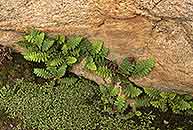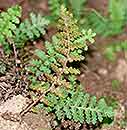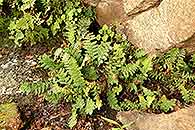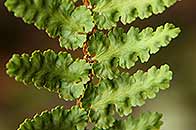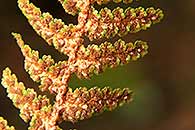Asplenium cordatum (Thunb.) Sw.
Synonyms |
Ceterach cordatum (Thunb.) Desv. |
|---|---|
Common name |
|
Description |
Rhizome erect or procumbent, 3-6 mm in diameter, scales dark brown, up to 4.5 mm long, lanceolate, tapering, margin paler. Fronds not proliferous, tufted, erect. Stipe short, up to 60 mm long, dark chestnut brown; scales shining, lanceolate, c. 3.5 mm. Lamina 2-15 × 1-5 cm, shallowly to deeply 2-pinnatifid, elliptic to oblanceolate in outline, subcoriaceous, inrolled when dry; basal pinnae gradually decrescent. Pinnae free, oblong-lanceolate, margins irregularly scalloped to incised, apex bluntly acute, base heart-shaped, undersurface very densely covered with pale reddish-brown scales. Rhachis not winged between pinnae; scales dark chestnut brown, lanceolate, 3mm long. Sori linear, up to 2 mm long, hardly visible because of the covering scales, exindusiate. |
Notes | Until recently all Southern African ceterachoid aspleniums were treated as a single taxon displaying a lot of variation, now 2 other species are recognized: A. capense and A. phillipsianum. These are herbacious, with a less divided lamina, they have pinnae that are completely or partialy attached to the rachis, a rachis that is completely or partialy winged and sori that are much better visible because of sparse scale covering.
|
Derivation | cordatum: heart-shaped, referring to the two basal lobes of the pinna. |
Habitat | In a wide variety of habitats where it is often found in rock crevices or beneath boulders, sheltered from sun and wind. Terrestrial or lithophyte. |
Distribution worldwide | See African distribution. |
Distribution in Africa |
Angola, Botswana, Kenya, Lesotho, Namibia, Somalia, South Africa, Tanzania , Uganda, Zimbabwe. |
Growth form |
Lithophytic, terrestrial. |
Literature |
|
